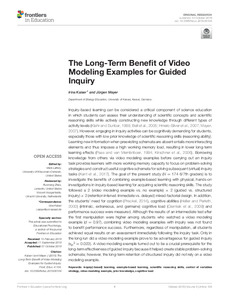| dcterms.abstract | Inquiry-based learning can be considered a critical component of science education in which students can assess their understanding of scientific concepts and scientific reasoning skills while actively constructing new knowledge through different types of activity levels (Klahr and Dunbar, 1988; Bell et al., 2005; Hmelo-Silver et al., 2007; Mayer, 2007). However, engaging in inquiry activities can be cognitively demanding for students, especially those with low prior knowledge of scientific reasoning skills (reasoning ability). Learning new information when preexisting schemata are absent entails more interacting elements and thus imposes a high working memory load, resulting in lower long-term learning effects (Paas and van Merriënboer, 1994; Kirschner et al., 2006). Borrowing knowledge from others via video modeling examples before carrying out an inquiry task provides learners with more working memory capacity to focus on problem-solving strategies and construct useful cognitive schemata for solving subsequent (virtual) inquiry tasks (Kant et al., 2017). The goal of the present study (N = 174 6/7th graders) is to investigate the benefits of combining example-based learning with physical, hands-on investigations in inquiry-based learning for acquiring scientific reasoning skills. The study followed a 2 (video modeling example vs. no example) × 2 (guided vs. structured inquiry) × 2 (retention interval: immediate vs. delayed) mixed-factorial design. In addition, the students' need for cognition (Preckel, 2014), cognitive abilities (Heller and Perleth, 2000) (intrinsic, extraneous, and germane) cognitive load (Cierniak et al., 2009) and performance success were measured. Although the results of an intermediate test after the first manipulation were higher among students who watched a video modeling example (d = 0.97), combining video modeling examples with inquiry was not found to benefit performance success. Furthermore, regardless of manipulation, all students achieved equal results on an assessment immediately following the inquiry task. Only in the long run did a video modeling example prove to be advantageous for guided inquiry (ηp2 = 0.023). A video modeling example turned out to be a crucial prerequisite for the long-term effectiveness of guided inquiry because it helped create stable problem-solving schemata; however, the long-term retention of structured inquiry did not rely on a video modeling example. | eng |

